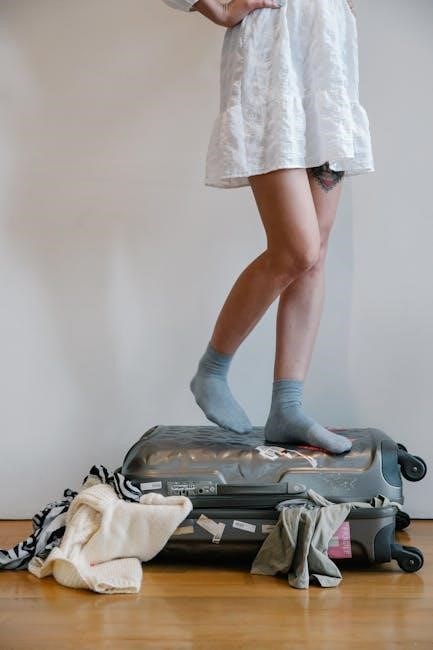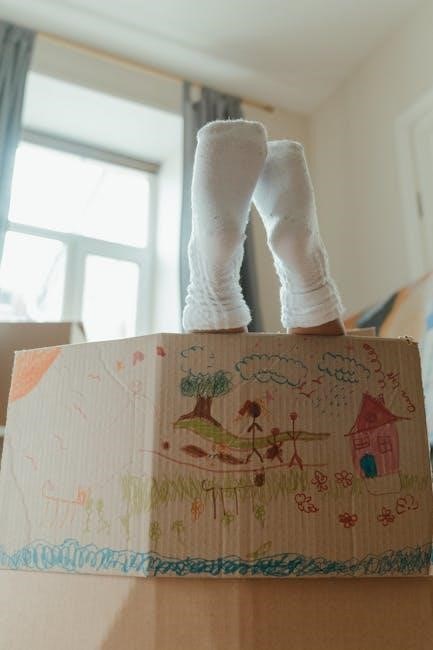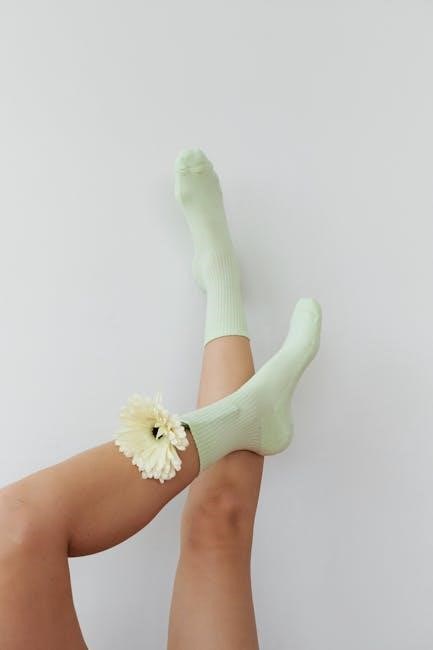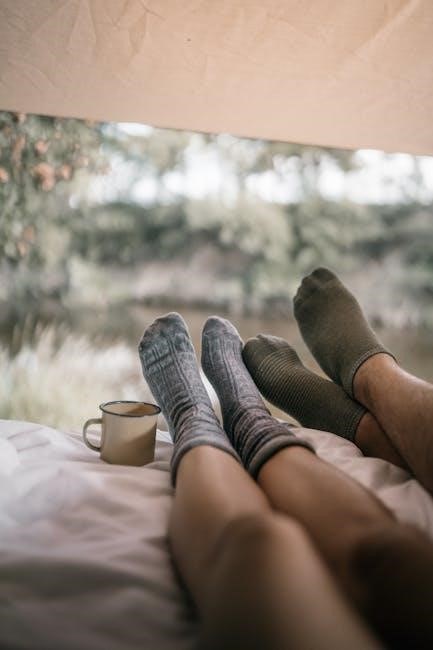Discover the importance of finding your perfect sock size with our comprehensive guide. Learn how proper fit enhances comfort and performance, and get tips on measuring and selecting the ideal pair.
Importance of Finding the Right Sock Size
Finding the right sock size is crucial for comfort, health, and performance. Ill-fitting socks can lead to blisters, discomfort, and even foot health issues. Properly sized socks provide adequate support, prevent slipping, and ensure optimal circulation. They also enhance athletic performance by reducing distractions and improving shoe fit. Additionally, the right size prevents excessive wear and tear, extending the life of your socks. Investing time in finding your perfect size ensures a more enjoyable and healthy footwear experience.
Understanding Sock Sizes and Their Impact on Comfort
Sock sizes play a critical role in comfort by ensuring proper fit and support. A well-fitting sock prevents pressure points, reduces friction, and eliminates bunching or slipping. It promotes even moisture distribution, preventing blisters and discomfort during activities. Properly sized socks also enhance breathability and maintain foot alignment, reducing fatigue. Ill-fitting socks, on the other hand, can cause irritation, restrict movement, and lead to foot health issues over time. Thus, correct sizing is essential for all-day comfort and performance.

How Sock Sizes Are Determined
Sock sizes are determined by foot length, measured in inches or centimeters, with regional standards varying between US, EU, and UK sizing systems.
Standard Sock Size Charts and Measurements
Standard sock size charts are based on foot length measurements, typically ranging from small to extra-large sizes. These charts vary slightly by region, with the US, EU, and UK having distinct sizing systems.
Measurements are usually provided in inches or centimeters, with each size corresponding to a specific range. For example, a size 9-11 might fit feet measuring 9 to 11 inches in length. These charts help consumers choose the right fit, ensuring comfort and performance for various activities and preferences.
How Foot Length Translates to Sock Size
Sock sizes are primarily determined by foot length, with each size corresponding to a specific range of measurements. For example, a size 7-9 sock fits feet measuring 7 to 9 inches in length. This standard ensures consistency across brands, allowing consumers to choose the right fit based on their foot length. Accurate measurement is crucial to avoid ill-fitting socks, which can cause discomfort or blisters. Always measure the longest part of your foot for the best results.

Measuring Your Foot for the Perfect Fit
To ensure a comfortable and accurate fit, measure your foot length and circumference. Use a flexible tape measure or trace your foot on paper to determine size. Consider both feet, as they may differ slightly. Measure in the evening, as feet tend to swell during the day. This method helps in selecting the right sock size for optimal comfort and performance.
Tools and Techniques for Accurate Foot Measurement
For precise foot measurement, use a flexible tape measure or a ruler. A Brannock device, commonly found in shoe stores, is ideal for accuracy. Trace your foot on paper to measure length and width. Always measure both feet, as they may differ. Stand upright and measure in the evening, as feet swell during the day. Wear the same thickness of socks you plan to use with the socks for an accurate fit. This ensures comfort and prevents sizing errors.
How to Measure Foot Length and Circumference
To measure foot length, place your foot flat on the floor and measure from the back of the heel to the tip of the longest toe. For circumference, wrap a flexible tape measure around the widest part of the ball of your foot. Stand upright and measure both feet, as they may differ slightly. Use these measurements to align with size charts, ensuring a snug yet comfortable fit. Natural foot swelling during the day can affect sizing accuracy.

Sock Size vs. Shoe Size
Sock size relates to shoe size but considers foot circumference, thickness, and personal fit preferences for optimal comfort and performance.
Understanding the Relationship Between Shoe and Sock Sizes
Sock and shoe sizes are related but distinct measurements. While shoe size primarily reflects foot length, sock size accounts for both length and circumference. Socks must align with shoe size to ensure comfort and prevent blisters. However, variations in foot shapes and personal preferences can affect the fit. For instance, thicker socks may require a slightly larger shoe size for optimal comfort. Always measure your feet and consult size charts for accuracy, as sizing can vary between brands and activities.
How to Convert Shoe Size to Sock Size
Converting shoe size to sock size isn’t always straightforward, as sock sizes also depend on foot circumference and thickness. Generally, sock sizes align closely with shoe sizes but may vary slightly. Start by using a standard size chart, then adjust based on whether the socks are thin or thick. Measure your foot length and circumference for accuracy. If unsure, opt for a slightly larger sock size to ensure comfort and avoid tightness. Always check brand-specific charts for precise conversions.
Regional Sizing Differences
Sock sizes vary across regions, with different standards in the US, EU, and UK. Always check regional charts to ensure the best fit and comfort for your feet.
US vs. EU vs. UK Sock Size Comparisons
Sock sizes differ significantly between the US, EU, and UK due to varying measurement systems. US sizes are based on the Brannock Device, while EU sizes use the Paris Point system, measuring length in centimeters. UK sizes align closely with EU standards but may vary slightly. These regional differences can lead to confusion, especially when shopping internationally. Always refer to size conversion charts or measure your foot length directly for the best fit across regions.
How to Navigate Sizing Variations Across Brands
different brands often have unique sizing standards, making it challenging to find consistent fits. always check the brand’s specific size chart before purchasing, as some may run smaller or larger than others. consider reading reviews to gauge how others perceive the fit. additionally, some brands offer dual sizing or adjustable features to accommodate varying foot shapes. if unsure, contact customer service for guidance to ensure the best fit for your needs.
Material and Thickness Considerations
Materials like cotton, wool, and synthetic blends affect fit and comfort. Thicker socks provide warmth, while thinner options offer breathability. Choose based on activity and season.
How Fabric Weight Affects Sock Size Fit
Fabric weight significantly impacts sock fit. Heavier fabrics, like thick wool, compress more, potentially making socks feel tighter. Lighter materials, such as breathable synthetics, stretch more easily. This can affect how sizes correspond to foot dimensions. Thicker socks may require a larger size for comfort, while thinner styles might fit true to size. Understanding fabric weight helps in selecting the right size for optimal comfort and performance, especially for specific activities or seasonal wear.
Choosing the Right Thickness for Different Activities
The thickness of socks plays a crucial role in comfort and performance during various activities. For sports, thicker socks provide cushioning and support, reducing friction and blisters. Thin socks are ideal for formal or casual wear, offering a sleek fit. Medium thickness works well for daily use, while ultra-thin socks are great for tight-fitting shoes. For outdoor activities, moisture-wicking socks with moderate thickness are best. Choose thickness based on activity type to ensure optimal comfort and functionality.

Sock Length and Style Options
Sock lengths vary from no-show to over-the-calf, offering style and comfort for different activities. Styles cater to specific needs, ensuring optimal fit and functionality.
Understanding Different Sock Lengths (No-Show, Ankle, Crew, etc.)
Socks come in various lengths to suit different preferences and activities. No-show socks are invisible above the shoe, ideal for casual wear. Ankle socks offer minimal coverage, perfect for sports. Crew socks reach mid-calf, providing comfort and versatility. Mid-calf and over-the-calf styles are longer, often used for formal or cold-weather wear. Each length serves specific purposes, ensuring comfort and practicality for various occasions and footwear types.
How Sock Style Impacts Size and Fit
Sock style significantly influences size and fit. Crew socks require a snug fit around the calf, while no-show socks need a secure heel to stay hidden. Ankle socks fit tightly to avoid slipping, and compression socks are designed for a firmer fit. Different styles prioritize comfort, support, or aesthetics, so choosing the right size depends on the sock’s intended use and design. Proper fit ensures comfort and prevents issues like blisters or restricted movement during activities.

Activity-Specific Sock Sizes
Activity-specific socks vary in size and fit based on performance needs. Running socks offer cushioning, while hiking socks provide durability. Sports socks prioritize moisture-wicking fabric and snug fits to prevent blisters during intense activities.
- Running: Cushioned heel and toe for impact absorption.
- Hiking: Thicker, durable materials for rugged terrain.
- Sports: Moisture-wicking fabric and seamless construction.
Proper fit ensures comfort and prevents blisters during activities.
Sport-Specific Sock Sizes and Fit Requirements
Sport-specific socks are tailored to meet the demands of particular activities. For high-impact sports like basketball, thicker cushioning and arch support are essential. Cycling and running benefit from compression socks to improve blood flow. Football and soccer socks often feature moisture-wicking fabrics to keep feet dry. Fit requirements vary, with snug, blister-preventing fits for running and slightly looser fits for sports requiring lateral movement. Proper sizing ensures optimal performance and comfort during intense activities.
How to Choose Socks for Formal or Casual Wear
Choosing socks for formal or casual wear involves considering fabric, thickness, and style. For formal events, opt for lightweight, breathable materials like cotton or silk in neutral colors. Casual settings allow for thicker, softer fabrics like wool or fleece. Match sock color to your outfit for a polished look. Patterns and bold colors can add personality to casual wear. Ensure socks align with the occasion while maintaining comfort and practicality. Pairing the right sock with your attire enhances both style and functionality.
Age and Gender-Specific Sizing
Sock sizes vary by age and gender to accommodate different foot shapes and growth stages, ensuring comfort and proper fit for children, men, and women.
Kids’ Sock Sizes and Growth Considerations
Kids’ sock sizes are designed to accommodate rapid growth, with sizes based on age ranges and foot length. Socks for children often feature stretchy materials to allow for growth spurts. Measurements typically range from infant sizes to youth sizes, ensuring a snug yet comfortable fit. Regular measurement is essential as children’s feet grow quickly. Parents should consider activity levels when choosing sock thickness and style, ensuring durability and comfort. Proper fit is crucial to prevent blisters and support healthy foot development.
Men’s vs. Women’s Sock Size Differences
Men’s and women’s sock sizes differ due to variations in foot shape and size. Men’s feet are generally larger and wider, while women’s feet are typically narrower. Sock sizes are often categorized separately, with men’s sizes starting at larger numbers. Women’s socks may include smaller sizes and slimmer fits. Some brands offer unisex options, but most tailor sizes to gender-specific foot shapes. Proper fit is crucial for comfort, so choosing the right size based on gender-specific measurements is recommended.

Common Mistakes in Choosing Sock Sizes
Common mistakes include guessing sizes instead of measuring, ignoring thickness, and not considering activity-specific needs, leading to discomfort and poor fit.
Why People Often End Up with Ill-Fitting Socks
Many individuals end up with ill-fitting socks due to guessing sizes without proper measurement, ignoring foot shape and arch type, and not considering brand-specific fits. Additionally, failing to account for fabric stretch, activity needs, and personal comfort preferences can lead to discomfort or poor performance. Socks that are too tight may restrict circulation, while loose ones can cause blisters or slipping, emphasizing the importance of accurate sizing for optimal comfort and functionality.
How to Avoid Sizing Errors
To avoid sizing errors, always measure your feet accurately and consult the specific brand’s size chart, as sizing can vary. Consider the sock’s material and thickness, as these affect fit. Be mindful of how socks may stretch or shrink with washing. Additionally, account for personal comfort preferences, such as snugness or looseness. Trying socks on when possible or reading reviews for fit feedback can also help ensure the best fit. Pay attention to sock length and type, like crew versus ankle socks, and ensure you’re selecting from the appropriate category for your needs, such as adult or children’s sizes.
Caring for Your Socks to Maintain Fit
Proper care ensures socks maintain shape and fit. Wash in cold water, avoid bleach, and air-dry to prevent shrinkage and fabric degradation. Store neatly to prevent stretching.
Washing and Drying Tips to Preserve Sock Shape
Wash socks in cold water using a gentle cycle to prevent shrinkage and fabric damage. Turn them inside out to protect patterns and reduce pilling. Avoid fabric softeners, as they can weaken elastic fibers. Air-dry socks instead of machine-drying, as heat can cause stretching or loss of shape. Reshape damp socks to their original form before drying to maintain fit. Proper care ensures socks retain their size, elasticity, and comfort over time.
How to Extend the Life of Your Socks
To extend the life of your socks, rotate them regularly to avoid excessive wear on specific pairs. Store them in a cool, dry place to prevent moisture buildup. Avoid over-drying, as this can weaken fibers. Mend small holes or tears promptly to prevent further damage. Consider using a fabric shaver to remove pilling without harming the material. By following these practices, you can enjoy your socks longer while maintaining their comfort and fit.

Troubleshooting Poor Fit
If socks feel too tight or restrictive, consider sizing up. For loose socks, opt for a smaller size or try a different style for better support.
What to Do If Your Socks Are Too Tight or Too Loose
If socks are too tight, they can cause discomfort or restrict circulation. Try sizing up or opting for a looser fit. If socks are too loose, they may bunch up or slip down. Consider a smaller size or a style with elastic cuffs for better grip. Always refer to the size chart and measure your foot accurately. If issues persist, check the material thickness or activity-specific designs, as these can affect fit. Proper fit ensures comfort and prevents blisters or irritation during wear.
How to Exchange or Return Socks That Don’t Fit
To exchange or return socks that don’t fit, start by reviewing the retailer’s return policy. Most brands allow returns within 30 days of purchase. Ensure the socks are in their original condition with tags attached. Visit the website or store where you purchased them and follow the return or exchange process. Provide proof of purchase and specify the reason for the return. Once processed, you’ll receive a refund, exchange, or store credit. Double-check details before submitting to avoid delays.

Frequently Asked Questions (FAQs)
Frequently Asked Questions (FAQs) about sock sizes address common concerns like fit, sizing charts, and returns, helping you make informed purchasing decisions easily.
Common Questions About Sock Sizes and Fit
How do I find my perfect sock size? Why do socks feel tight or loose? What’s the difference between shoe and sock sizes? How do materials affect fit? Can I measure my foot at home? These questions are common, and understanding them ensures a comfortable fit. Sock sizes vary by brand, so checking size charts is essential. Proper fit prevents blisters and discomfort, while the right material enhances performance.
Expert Answers to Sock Size-Related Queries
Experts recommend using standard size charts and measuring your foot accurately for the best fit. Sock sizes can vary slightly between brands, so always check the specific chart provided. Thicker socks may require a larger size, while thinner styles can be more forgiving. If possible, try socks on before buying, especially for athletic or specialized uses. Proper fit enhances comfort, prevents blisters, and ensures optimal performance, making it worth the extra effort to get it right.

Brand-Specific Sizing Variations
Different brands may have unique sizing standards, affecting fit. Materials and manufacturing processes can cause variations, so always check the specific size chart for the best fit.
Understanding Different Brands’ Sizing Standards
Different sock brands often have unique sizing standards due to variations in materials, manufacturing processes, and target demographics. Some brands cater to specific activities like sports or formal wear, influencing their size charts. Others may focus on comfort or fashion, altering how sizes fit. It’s essential to consult each brand’s size guide, as even similar sizes can vary significantly between manufacturers. This ensures the best fit and comfort tailored to the brand’s design preferences and your needs.
How to Compare Sizes Across Different Brands
To compare sock sizes across brands, start by referencing each brand’s specific size chart, as sizing can vary significantly. Measure your foot length and circumference to align with the brand’s measurements. Consider the material thickness, as thicker socks may require a larger size. Check user reviews for insights into fit consistency. Use conversion charts for international sizes if needed. This approach ensures a more accurate comparison and helps you find the best fit across different brands.
Understanding sock sizes ensures comfort and performance. Proper measurements and awareness of size variations help you make informed choices for everyday wear or specific activities.
Final Tips for Finding Your Perfect Sock Size
To ensure the best fit, always measure your feet accurately and consider your activity level. Choose materials that breathe and offer the right thickness for comfort. Try socks on in the afternoon, as feet tend to swell slightly during the day. Consult size charts and read reviews to gauge fit consistency. Remember, proper sock size enhances comfort, prevents blisters, and supports overall foot health. Prioritize quality and functionality for long-lasting wear.
Why the Right Sock Size Matters for Comfort and Performance
Proper sock size ensures optimal comfort, preventing blisters and discomfort. Ill-fitting socks can lead to foot fatigue, poor circulation, and even health issues like fungal infections. For athletes, the right size enhances performance by providing support and reducing distractions. Socks that fit well stay in place, reducing friction and moisture buildup. Prioritizing sock size is crucial for all-day comfort, whether for casual wear or high-intensity activities, ensuring your feet stay healthy and supported.


